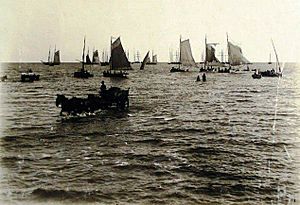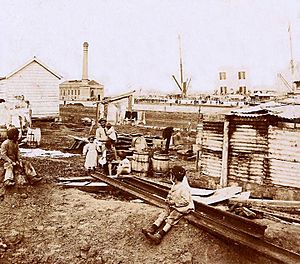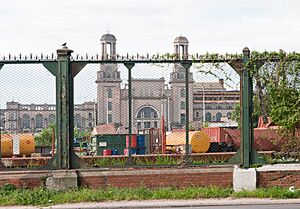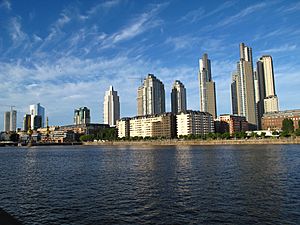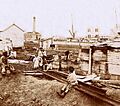Port of Buenos Aires facts for kids
Quick facts for kids Port of Buenos Aires |
|
|---|---|
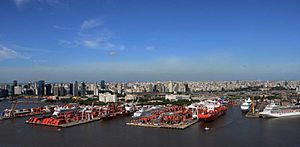 |
|
| Lua error in Module:Location_map at line 530: Unable to find the specified location map definition: "Module:Location map/data/yes" does not exist. | |
| Location | |
| Country | Argentina |
| Location |
|
| Coordinates | 34°35′S 58°22′W / 34.583°S 58.367°W (Puerto Nuevo) |
| Details | |
| Opened |
|
| Land area | 91 ha (220 acres) |
| Available berths | 51 |
| Draft depth | 10.7 m. |
| Interventor | Oscar Vecslir |
| Secretary General | Dr. Carlos Ferrari |
| Statistics | |
| Vessel arrivals | 1,900 (2010) |
| Annual cargo tonnage | 11.7 million metric revenue tons (2010) |
| Annual container volume | 1.1 million TEU (2010) |
| Passenger traffic | 336,000 passengers (2010) |
| Annual revenue | US$53 million (2008) |
| Net income | US$0.6 million (2008) |
The Port of Buenos Aires (Spanish: Puerto de Buenos Aires) is Argentina's most important seaport. It is managed by a government company called the General Ports Administration. This port is key for Argentina's trade with other countries.
The main part of the port today is known as Puerto Nuevo (New Port). It is located in the Retiro area of Buenos Aires. The Port of Buenos Aires handles about 11 million tons of cargo each year. Another port, Dock Sud, is south of the city. It handles even more cargo, around 17 million tons annually.
In the past, many immigrants arrived in Argentina through this port. Today, it mostly welcomes tourists visiting Argentina and Argentines traveling to Uruguay. Fast ferries, like Buquebus, connect Buenos Aires to cities in Uruguay. There are also boats that take tourists to Tigre, a popular place for weekend trips. The Benito Quinquela Martín Terminal, opened in 2000, is where many cruise ships dock.
Contents
History of the Port of Buenos Aires
How the Port Started
Buenos Aires was founded as a port city in 1580 by Captain Juan de Garay. This was for the Spanish Empire. However, merchants from Peru tried to stop its growth. They even had the port closed in 1595. This made people in Buenos Aires rely on smuggling goods. This illegal trade continued until 1776. That's when the Viceroyalty of Río de la Plata was created, which helped the port.
After this, exports like salted meat and cowhides grew a lot. Taxes on these goods became the main way the government made money. For a long time, ships used a natural harbor called Balizas Interiores. Before modern structures, Buenos Aires only had a small, shallow pier. It was hard for ships to reach because the city was on a hill. Also, a lot of silt (mud and sand) in the Río de la Plata river made it difficult for large ships to get close. Big merchant ships had to anchor far offshore. Passengers and cargo then moved to smaller boats to reach the shore.
In 1868, the Argentine Congress passed a law to study building a modern port. It was important for the port to be close to the city. This helped the government collect taxes easily. These taxes were the main source of public money for a long time. There were many arguments between Buenos Aires and other parts of Argentina about how to share this money.
In 1880, Buenos Aires became the capital city. This helped solve arguments about who controlled the port lands. A businessman named Francisco Seeber had already started building the Catalinas Warehouse and Pier in 1872. This new pier made it much easier for ships to dock. It was the first time land was created from the river for a port in Argentina. This pier served both cargo and passengers for 20 years.
Two Plans for a New Port
In 1881, President Julio Roca asked for plans for a much bigger port. Two main ideas were presented. One was by Luis Huergo, who worked on the Riachuelo River. His plan suggested docks built in a staggered way. The other plan was from a British design bought by businessman Eduardo Madero. Madero's plan got support from President Roca and Senator Carlos Pellegrini. It was approved in October 1882.
Madero hired British engineer Sir John Hawkshaw to design the new port. It was planned to have four connected docks. Construction started in 1884. The first dock was finished in 1888 and opened in 1889.
However, a financial crisis in 1890 slowed down the work. The port, known as Puerto Madero, was finally completed in 1897. By 1907, Puerto Madero was already too small for all the ships. It could handle about 30,000 tons of cereals daily. Cereals were Argentina's main export at the time. So, in 1907, President José Figueroa Alcorta approved expanding the port.
Luis Huergo's original plan for staggered docks was approved in 1911. Work quickly began on the Puerto Nuevo (New Port). This project was north of the Catalinas Norte area. World War I caused delays because materials and money were scarce. The project took 15 years to finish. It added a breakwater and six more docks. When these were opened in 1925, the Port of Buenos Aires became the largest in Latin America and the Southern Hemisphere.
How the Port Works Today
The Port of Buenos Aires is run by the General Port Administration, which is owned by the government. This organization was first created in 1949. It managed all major ports in Argentina. In the early 1990s, the port was losing a lot of money. So, in 1992, President Carlos Menem decided to sell off many government-owned businesses. However, he decided that the Port of Buenos Aires itself should remain under government control.
Argentina's shipping fleet was first developed by Nicolás Mihanovich. His company was very important in the late 1800s and early 1900s. Later, in 1949, President Juan Perón made the shipping fleet a government-owned company called Flota Mercante del Estado.
The New Port gets its electricity mainly from the Dr. Carlos Givogri power plant. This building was built in 1930 and has a unique design. It is one of the most recognizable buildings at the port. The Tandanor company is also located at the port. It builds and repairs ships. Tandanor is now run by its workers and is the largest shipbuilder in Argentina.
Puerto Madero's New Life
After the New Port opened in 1925, Puerto Madero was not used much for port activities. But in 1989, a plan was made to bring it back to life. Starting around 1994, a huge project began. Old red brick warehouses along the docks were turned into fancy offices, apartments, shops, restaurants, and hotels. New buildings were also constructed on the eastern side. This area also has some of the city's largest parks.
Puerto Madero has been redeveloped with help from famous architects. Today, it is one of the most modern and popular areas in Buenos Aires. Many young professionals and retired people choose to live there. Property prices have gone up, attracting people from other countries who want to invest.
The roads in Puerto Madero have been completely rebuilt, especially on the east side. There are wide boulevards and pedestrian streets. The Buenos Aires Ecological Reserve separates the district from the river. Puerto Madero is the biggest urban project in Buenos Aires right now. It has changed a lot in just ten years and is seen as one of the most successful waterfront renewal projects in the world.
Images for kids
See also
 In Spanish: Puerto de Buenos Aires para niños
In Spanish: Puerto de Buenos Aires para niños


